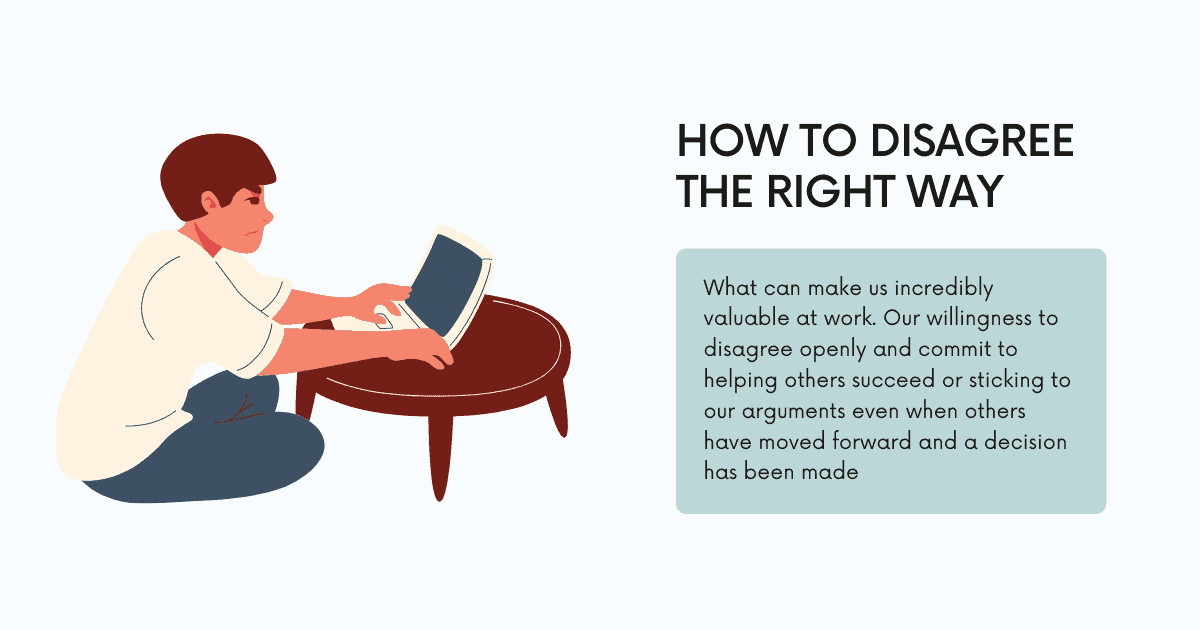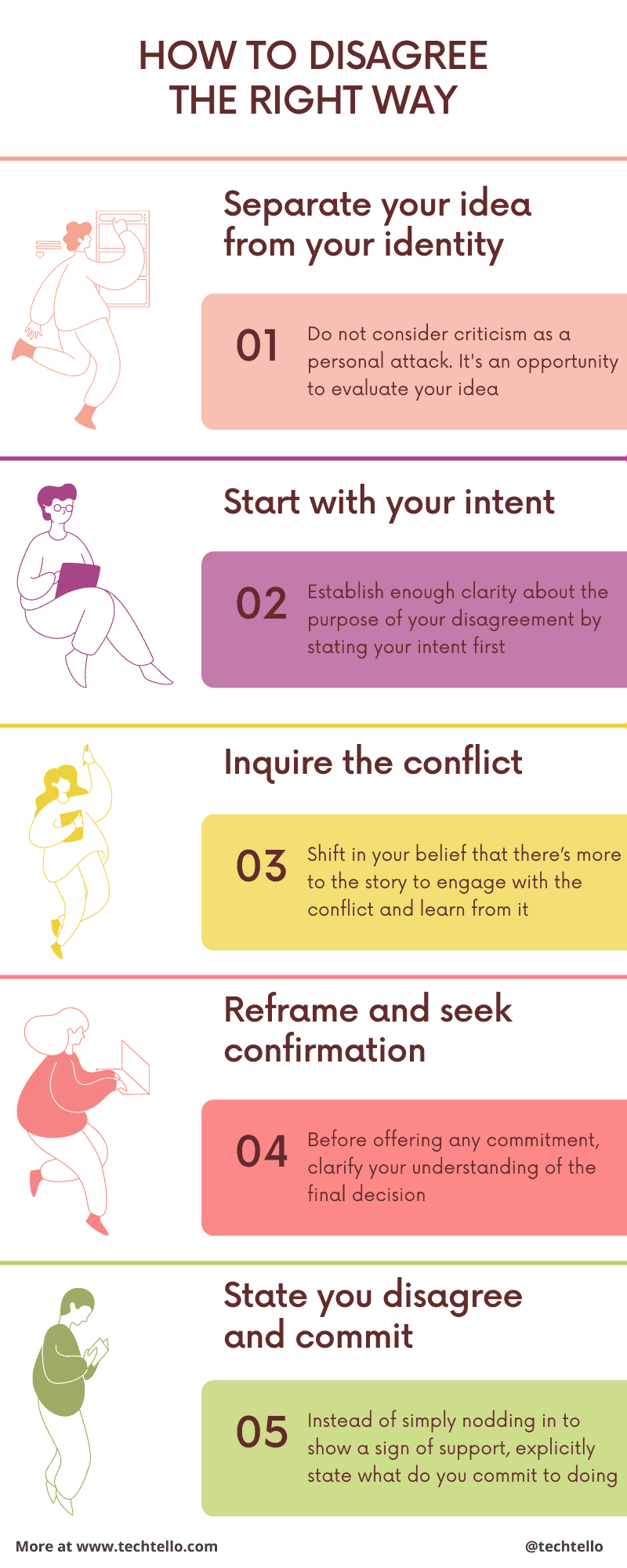Agree To Disagree vs Disagree And Commit: How To Disagree The Right Way

What can make us incredibly valuable at work – our willingness to disagree openly and commit to helping others succeed or sticking to our arguments even when others have moved forward and a decision has been made?
A decision that does not go our way is not an attack on our identity, and yet when others disagree with us or disregard our opinion, we take it personally.
The stronger our belief system, the more difficult it is for us to look beyond our own perspective and treat other people’s ideas worthy of consideration. Being stuck in right vs wrong can cause us to feel emotionally stressed out, prevent us from expressing our own ideas with the right frame of mind, and ignore what others have to say.
Instead of the conflict transpiring into a healthy debate to make a decision which is in the larger interest of the company, the difference of opinion takes on a personal agenda in which one side must lose for the other to win.
Eventually, when the decision does land in our favor or it’s not what we anticipated, it ends up hurting our emotions.
What should we do then? Just agree to disagree – agreeing to the fact that we disagree with the decision.
Why agree to disagree doesn’t work

Agree to disagree stems from a negative mindset that prevents us from moving forward. Depending on how strongly we view our opinion, it can make us ruminate over the decision, overthink why others cannot see our point of view and self-justify why the current decision is wrong.
Instead of accepting that it’s not about right vs wrong, us vs them, agree to disagree can make us adopt dismissive behavior and ignore the decision.
Dismissing the decision makes us non-committal and refrain from providing the necessary support to make the project successful. It can even make us secretly wish that the project fails so that we can go back and tell everyone “I told you so.”
Each of us tends to think we see things as they are, that we are objective. But this is not the case. We see the world, not as it is, but as we are—or, as we are conditioned to see it. When we open our mouths to describe what we see, we in effect describe ourselves, our perceptions, our paradigms. When other people disagree with us, we immediately think something is wrong with them. But, as the demonstration shows, sincere, clear headed people see things differently, each looking through the unique lens of experience – Stephen R. Covey, The 7 Habits of Highly Effective People
Difference of opinion is useful to seek diverse viewpoints, evaluate solutions from different points of view and make unbiased decisions. But, when it ends with the “agree to disagree” mindset, it sabotages the purpose of a group to come together and challenge each other while remaining committed to supporting each other.
Why disagree and commit instead

Disagree and commit divulges the importance of commitment despite our differences. At its core, it supports unity, maturity to disconnect our identity from our ideas and support others even when we do not agree with their point of view.
It doesn’t hide the fact that we disagree nor dismiss the value of our opinion, it simply guides us to know when it’s time to get past our conviction and work with others instead of working against them.
You can value the difference in other people. When someone disagrees with you, you can say, “Good! You see it differently.” You don’t have to agree with them; you can simply affirm them. And you can seek to understand – Stephen R. Covey, The 7 Habits of Highly Effective People
When disagreements reach a point of no consensus, the leader of the group typically takes a final call on the direction to take. Before devising any strategy and tactics, it’s important that the members of the group disagree and commit to this decision instead of agree to disagree.
A good way to get real support is by asking “I know that we disagree on this idea, but can you commit to supporting it. We cannot move forward without a commitment from all of you to make it successful.”
How to disagree and commit the right way
Disagreements are not only useful, they are essential to the long term success of any organization. Yet, the thought of a disagreement can creep us out, make us conform to others even when every cell in our body is shouting to speak up.
It can be a personal hesitation or a cultural nuance that can make us avoid disagreements–nod our head to an idea that we do not buy-in, keep our thoughts to ourselves with the worry that others might dislike it or do not speak up with the fear of rejection or reprisal.
Disagreements managed right can help us build an independent viewpoint, expand our circle of competence by hearing diverse opinions, reflect on our own thinking and approach conflict with a growth mindset as opposed to an attack on our intelligence or abilities.
Without an opportunity to explore and express our thoughts, can we really commit wholeheartedly and support conflicting opinions? How can we disagree and commit in a productive manner?
Follow these 5 steps to disagree the right way:
1. Separate your idea from your identity
You may have a great idea or a really bad one. The only way to know its worth is to seek honest feedback from others and that involves being able to take in criticism.
If you are too connected to your ideas and consider it a part of your identity, then even a slight hint of objection can shatter you to a thousand pieces and you can lose the opportunity to objectively consider a different point of view.
In such moments, criticism may seem like a personal attack as you resort to thinking “they are calling me bad” and fail to consider “they are calling my idea bad.”
Catmull, an American computer scientist who was a co-founder of Pixar and president of Walt Disney Animation Studios describes in Creativity, Inc “You are not your idea, and if you identify too closely with your ideas, you will take offense when they are challenged.”
Before disagreeing, take a moment and tell yourself:
- I am not my idea.
- I commit to sharing without fear and anxiety.
- Rejection of my idea gives me an opportunity to update my belief system.
- It’s better to know than to assume I am right.
2. Start with your intent
If you do not state your intent, people will create their own stories that fit their belief system. Their mind will not shut up without building up a conceivable notion that explains your behavior “he/she thinks like this because…..”
Disagreements in particular may lead to interpretations that are far from the reality of your situation and your intent.
So, before you disagree, ask yourself:
- Why do I really disagree?
- What’s my intent in sharing my disagreement?
- Why do I think not sharing my disagreement is wrong?
With enough clarity about the purpose of your disagreement, start by stating your intent first.
“I intend to share my opinion to help us [….]. Though the current solution covers […], it’s missing […]”
3. Inquire into the conflict
When entering a conflict, it’s easy to ignore the other side of the argument and stick to what you know. Confirmation bias can also make you selectively gather data to fit your beliefs as opposed to using opposing views to update your mental models.
Instead of engaging in finding a common solution, it becomes a battle of self-righteousness “I am right, you are wrong.”
The secret lies in changing your mindset. The standard mindset is either/or. Either you are right or your opponent is. The alternative mindset is both/and – he can be right in terms of his experience, and you can be right in terms of yours – William Ury, Getting Past No
The shift in belief that there’s more to the story gives permission to your brain to engage with the conflict and learn from it by inquiring:
- Why is this important to me?
- Why does the other person think this way?
- What can I learn by listening to another person?
- What does their perspective teach me?
- How can I apply Hanlon’s razor to learn about the other person?
Listening intently to the other person without judgment is the first step to commitment. It does not mean that you agree to their viewpoint.
4. Reframe different positions and seek confirmation
In the end, the discussion may lead to a decision you do not agree with and that should be a sign to shift gears.
Be content in the knowledge that you were true to yourself by saying what you had to say, you listened to diverse viewpoints and did your best to help make the right decision.
Before offering any commitment, it’s important that you clarify your understanding on the final decision:
- State your understanding of the final decision.
- Re-emphasize why you still think the decision is wrong and state risks as you see.
- Confirm your understanding by asking clarifying questions.
Respect the decision instead of being in contempt of it. It’s time to put on your commitment hat.
5. State you disagree and commit
Disagree and commit reflects the mindset of a team over an individual, maturity to do what’s in the best interest of the group and sign of a leader who can rise to difficult situations by embracing the new reality.
Instead of simply nodding in to show a sign of support, explicitly state what do you commit to doing:
- Clarify what this commitment means to you and your team.
- Engage by seeking the same information from others.
- Discuss the strategy and tactics that need to be employed to make this decision successful.
Instead of waiting for your thinking to align with the new reality and trigger the right action, act first. Your action will slowly shift your belief system.
Don’t just agree to disagree, shift to disagree and commit since that’s the hallmark of great leadership.


































Brilliant article @VinitaBansal. Totally resonate with your views and ideas. Thanks for making the post. Have shared it with my community as well. You briefly touched upon how one can improve chances of acceptance of their ideas (“start with intent”), but I would like to read more from you on that. I feel the key points here also apply very well for how people engage in social media these days. I am sure people can learn something from your post here (like I have).
Hi Sivam,
Thanks for writing your views on this topic.
Sharing our intent when we disagree is the key to starting on the right note and ensuring people relate to our thoughts based on “why” we disagree as opposed to making up stories in their own mind. Agree that it’s a topic in itself. Thanks for suggesting. I will try to cover it in details in a future post.
Conflicts and disagreements are a part of our life and yes we can use a lot of the same tools for effective communication.
Thanks,
Vinita
I like your blog as it delves into conflicts and disagreements which are very frequently fuelling tensions everywhere whether unwittingly or purposefully …
Thank you Sahib
thank you for msgs
I was wondering if you have any resources that provide evidence that back up this piece, because I like the concept of agree and commit.